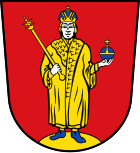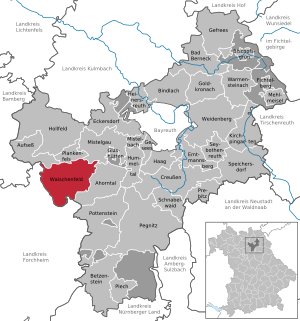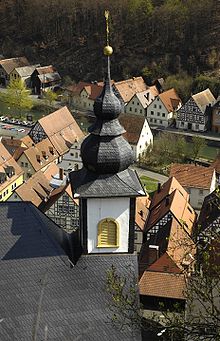Waischenfeld
| coat of arms | Germany map | |
|---|---|---|

|
Coordinates: 49 ° 51 ' N , 11 ° 21' E |
|
| Basic data | ||
| State : | Bavaria | |
| Administrative region : | Upper Franconia | |
| County : | Bayreuth | |
| Height : | 372 m above sea level NHN | |
| Area : | 57.94 km 2 | |
| Residents: | 3066 (Dec. 31, 2019) | |
| Population density : | 53 inhabitants per km 2 | |
| Postal code : | 91344 | |
| Area code : | 09202 | |
| License plate : | BT, EBS , ESB , KEM , MÜB , PEG | |
| Community key : | 09 4 72 197 | |
| LOCODE : | DE WCN | |
| City structure: | 29 districts | |
City administration address : |
Marktplatz 1 91344 Waischenfeld |
|
| Website : | ||
| Mayor : | Thomas Thiem ( CSU ) | |
| Location of the city of Waischenfeld in the Bayreuth district | ||
Waischenfeld is a town in the Upper Franconian district of Bayreuth . The state-approved climatic health resort with Waischenfeld Castle, first mentioned in 1122, is located in the upper Wiesent valley in Franconian Switzerland .
geography
City structure
The city of Waischenfeld has 29 districts :
|
There are the districts of Breitenlesau, Eichenbirkig, Gösseldorf, Hannberg, Köttweinsdorf, Langenloh, Löhlitz, Nankendorf, Seelig, Waischenfeld.
Neighboring communities
Neighboring communities are (starting from the north clockwise): Plankenfels , Mistelgau , Ahorntal , Gößweinstein , Wiesenttal and Aufseß .
history
Until the church is planted
Waischenfeld Castle was first mentioned in a document in 1122. Wirint von Wischenvelt stipulated in the contract that all his possessions should pass to the clergy if his son Konrad remained without male descendants. Ulrich von Waischenfeld handed over his property to the brothers Eberhard III after 1216 for an unknown reason. and Ulrich III. from Greifenstein . Eberhard III. built a small castle above the powder mill and called itself from 1219 " von Schlüsselberg ". Waischenfeld remained in the possession of Schlüsselberger until 1348/49.

King Ludwig the Bavarian granted Waischenfeld town charter in 1315. After the death of the city lord Konrad II von Schlüsselberg in 1348, the castle and town of Waischenfeld came into the possession of the Bamberg diocese , which from 1500 belonged to the Franconian Empire . Waischenfeld became an important border base of the Bamberg prince-bishop . In the Peasants' War of 1524-26, the peasants in Franconia also rose up to fight the feudal system that imposed high duties and taxes on them. At that time the stone bag, the symbol of the city, is said to have been destroyed. During the Second Margrave War , Albrecht II. Alcibiades took possession of Waischenfeld in May 1552 and lost it again to the bishopric in autumn of that year . After a second conquest in January 1553 and another loss in February, the Margraves finally conquered Waischenfeld on March 3, 1553. Captain Paulus Herdegen sacked the city and set it on fire on July 7, 1553. More than 80 houses, including the town hall, fell victim to the flames.
During the Thirty Years War the Swedes tried several times in vain to take the Waischenfeld Castle. On August 9, 1632 , they pillaged the place, with the exception of the church and the castle, the remaining 149 houses were destroyed. The present castle and the stone bag date from the 18th century. The Waischenfeld Malefizbuch , a book with court records for the town and office of Waischenfeld, has been preserved from the period from 1680 to 1751 .
In the middle of the 18th century Waischenfeld was occupied by the Prussians . In May 1759 they looted the place and caused a damage of 32,100 guilders . French troops entered the country four decades later . Napoleon ensured that Waischenfeld became Bavarian on November 22, 1802 . On the way back from the Battle of Waterloo in 1815, around 3,600 Russian soldiers passed through Franconian Switzerland and Waischenfeld. The Russian linden tree and a memorial marten near Breitenlesau remind of this turbulent time . The city wall, which was still more than 1500 meters long in 1820, fell victim to the lively construction activity of the 19th century.
20th century
As of August 1943 was out in the Old Rentamt in Waischenfeld Berlin outsourced service of the Nazi Ahnenerbe under Wolfram Sievers with around 40 employees located. The "Ahnenerbe", a pseudoscientific association of the SS , organized deadly human experiments in concentration camps from Waischenfeld . On April 14, 1945, the place was occupied by the Americans , to whom, apart from minor skirmishes with the SS and a tank barrier , he surrendered without a fight. Thus the city was spared destruction. Sievers was picked up nearby two weeks later, sentenced to death at the Nuremberg Doctors' Trial in 1947 and executed in 1948.
Incorporations
On the occasion of the Bavarian regional reform , the town of Waischenfeld was enlarged several times. On January 1, 1971, the former communities of Gösseldorf and Seelig were incorporated. The community name Gösseldorf had replaced the previously valid name Heroldsberg in 1870. On January 1, 1972, part of the former community of Nankendorf was added. Hannberg, Langenloh and Rabeneck (Association of Municipalities and Eichenbirkig Köttweinsdorf in 1865) previously the district Pegnitz were followed on 1 July 1972. Waischenfeld himself came from the defunct district Ebermannstadt to district Bayreuth . On January 1, 1977 Waischenfeld took on the greater part of the dissolved municipality of Breitenlesau. On May 1st, 1978 part of the area was reclassified from Plankenfels to the town of Waischenfeld. On September 1, 2010, a part of the community-free area Löhlitzer Wald was added. On March 1, 2020, parcels from the former community-free area Langweiler Wald were incorporated.
Population development
In the period from 1988 to 2018, the city grew from 3,037 to 3,083 by 46 inhabitants or 1.5%. A peak was reached on December 31, 2002 with 3222 inhabitants.
politics
Thomas Thiem (CSU) from Siegritzberg has been mayor since May 1, 2020. His predecessor since July 1998 was Edmund Pirkelmann (Bürgerblock Breitenlesau-Siegritzberg).
The local elections on March 16, 2014 resulted in the following distribution of the 16 city council seats:
- CSU : 3
- SPD : 1
- BBN (Bürgerblock Nankendorf): 2
- FWSL (Free Voters City and Country): 2
- WWL (Waischenfeld-Land voter community): 3
- WGL (community of voters Löhlitz): 1
- BBS (Bürgerblock Breitenlesau-Siegritzberg): 2
- JW (Young Waischenfeld): 2
Intermunicipal cooperation
The city of Waischenfeld has been a member of the association for regional development “Around the Neubürg - Fränkische Schweiz e. V. "
Culture and sights
Buildings


- The Anna Chapel is a simple Romanesque building. The church was first mentioned in 1509 as part of a fundraising campaign. The altar, which dates from around 1660, has baroque style elements. The altarpiece, painted in oil by the former pastor in 1851, shows St. Anne with the Virgin Mary and the baby Jesus on her lap.
- Waischenfeld Castle with the Steinerner Beutel tower. The landmark of the city stands west of the city on a rocky plateau. The round, about 13 meter high tower stands on a limestone cliff and formed the northernmost part of the long-defunct Waischenfeld Castle. The castle and tower were probably built in the 13th century.
- The town chapel of St. Laurentius and St. Michael has a baroque interior and has a particularly beautifully designed Radiant Madonna from the 15th century.
- The choir of the parish church of St. John the Baptist dates back to 1450. The church was redesigned in the baroque style in 1750.
Literary Trail Group 47
In 1967 the last meeting of Group 47 took place in the powder mill in Waischenfeld. 50 years later, in October 2017, the anniversary of this important event was celebrated. 18 of the authors of the time came to this historic reunion. As a result of this anniversary weekend, the group 47 literature trail was inaugurated in 2018. The steles, distributed over 5 stations, are a unique place in Germany to commemorate Group 47, which played such an important role in post-war literature and the development of the still young democracy.
Sports
- From October 1990 to January 1991, the former world chess champion Bobby Fischer , who had not played an official game since the 1972 World Cup and has since gone into hiding, is said to have been quartered in the powder mill without being recognized and also to have played against various people during this time. After another former world chess champion - Michail Botvinnik - stayed in the same inn for a few days in 1993 , high-level chess tournaments are held there on a regular basis. a. German Bundesliga matches.
Breweries
In the urban area of Waischenfeld there are the breweries Heckel in Waischenfeld, Schroll in Nankendorf and Krug in Breitenlesau.
Others
The Wagnerfels on the Wiesent on the southern edge of the city is named after the composer Richard Wagner . The Franconian Mountain Trail and the Franconian Marienweg run through the village .
Natural monuments
- Russian linden tree in the district of Breitenlesau with a chest height circumference of 8.29 m (2014).
Personalities
Honorary citizen
- Rudolf Eberhard (1914–1998), Bavarian Minister of Finance
- Heinz Gerhäuser , former head of the Fraunhofer Institute for Integrated Circuits and former holder of the chair for information technology at the Friedrich-Alexander-Universität Erlangen-Nürnberg
- Josef Kraus, Dean, pastor of Waischenfeld 1976–1992
- Konrad Pieger, pastor of Waischenfeld 1937–1954
- Hans Schweßinger (1937–2011), 1966–1998 Mayor of Waischenfeld
- Hans Völker, pastor of Waischenfeld from 1956–1974
- Gunda Zeitler, patroness
sons and daughters of the town
- Ulrich Burchard , music writer, traceable between 1500 and 1531
- Friedrich Nausea (around 1496–1552), Bishop of Vienna
- Ernst von Bomhard (1833–1912), lawyer, President of the Senate at the Imperial Court in Leipzig
- Michel Hofmann (1903–1968), State Archives Director in Würzburg, employee at Carl Orff 's Carmina Burana
- Anton Sterzl (1927–2015), historian, journalist and author
literature
- Johann Kaspar Bundschuh : Weischenfeld . In: Geographical Statistical-Topographical Lexicon of Franconia . tape 6 : V-Z . Verlag der Stettinische Buchhandlung, Ulm 1804, DNB 790364328 , OCLC 833753116 , Sp. 136-137 ( digitized version ).
- Thomas Greif: The SS Waischenfeld location 1934–1945. Aid camp and Ahnenerbe. Erlangen 2006 (Series of publications by the Franconian Switzerland Association II: The Franconian Switzerland, local history supplements 16). ISBN 3-7896-0652-9
- Pleikard Joseph Stumpf : Waischenfeld . In: Bavaria: a geographical-statistical-historical handbook of the kingdom; for the Bavarian people . Second part. Munich 1853, p. 596-597 ( digitized version ).
- Pleikard Joseph Stumpf : Rabeneck . In: Bavaria: a geographical-statistical-historical handbook of the kingdom; for the Bavarian people . Second part. Munich 1853, p. 626 ( digitized version ).
Web links
- Entry on Waischenfeld's coat of arms in the database of the House of Bavarian History
Individual evidence
- ↑ "Data 2" sheet, Statistical Report A1200C 202041 Population of the municipalities, districts and administrative districts 1st quarter 2020 (population based on the 2011 census) ( help ).
- ↑ Waischenfeld community in the local database of the Bavarian State Library Online . Bayerische Staatsbibliothek, accessed on January 5, 2020.
- ↑ a b c d e War events in Waischenfeld on the city's homepage, accessed on March 4, 2018
- ↑ a b c When Hitler visited the Teufelshöhle in: Nordbayerischer Kurier from December 9, 2019, p. 15.
- ^ The Jewish skull collection of the SS in: Nordbayerischer Kurier of July 13, 2018, p. 20.
- ↑ See Thomas Greif: The SS location Waischenfeld 1934–1945. Aid camp and Ahnenerbe. Erlangen 2000 (Series of publications by the Franconian Switzerland Association II: The Franconian Switzerland, local history supplements 16). ISBN 3-7896-0652-9 .
- ^ Wilhelm Volkert (ed.): Handbook of Bavarian offices, communities and courts 1799–1980 . CH Beck, Munich 1983, ISBN 3-406-09669-7 .
- ^ Federal Statistical Office (ed.): Historical municipality directory for the Federal Republic of Germany. Name, border and key number changes in municipalities, counties and administrative districts from May 27, 1970 to December 31, 1982 . W. Kohlhammer, Stuttgart / Mainz 1983, ISBN 3-17-003263-1 , p. 675 and 677 .
- ^ Government of Upper Franconia: Upper Franconian Official Gazette, No. 2, 2020
- ↑ Preliminary result of the 2014 city council election on March 16, 2014 City of Waischenfeld
- ↑ About us - The Neubürg at a glance - Neubürg. Accessed June 8, 2020 (German).
- ^ Russian linden tree in the directory of monumental oaks . Retrieved February 5, 2017
- ↑ Heinz Gerhäuser honorary citizen of Waischenfeld , article on nordbayern.de (accessed on May 31, 2011)
- ↑ a b c Waischenfeld pastor with mention of honorary citizenship on the official Waischenfeld website (accessed on May 24, 2011)
- ↑ Father of the large community , article on nordbayern.de from January 9, 2011 (accessed on May 24, 2011)
- ↑ Honorary citizen of the city of Waischenfeld (accessed on May 24, 2011)
- ↑ Gunda Zeitler appointed honorary citizen of Waischenfeld , article on nordbayern.de (accessed on May 24, 2011)









